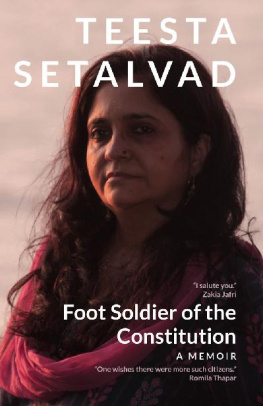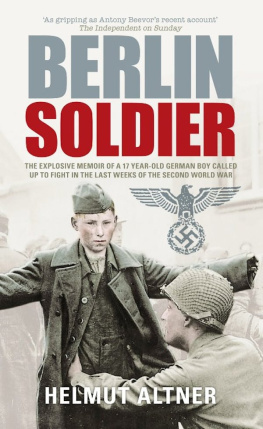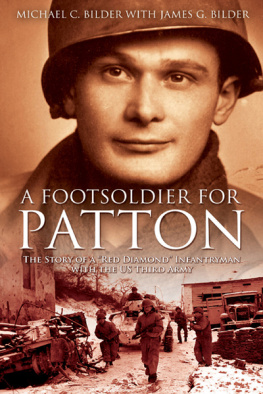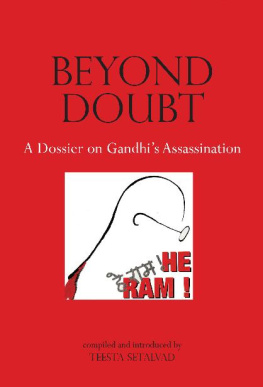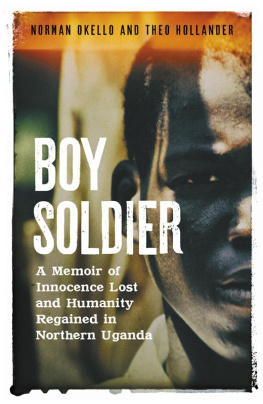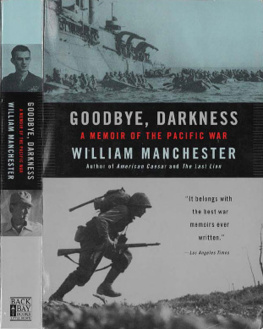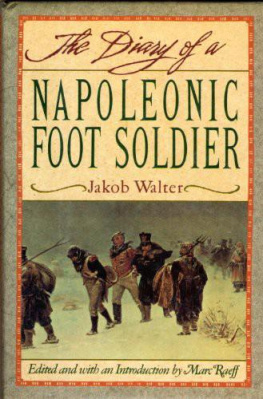Teestaji, I do not have words to express what you have meant to me, your importance in my life. You have immense courage. Your action compels us to bow our heads in respect. We feel proud to be seen with you and our cause has been your cause and the cause of all peace loving individuals. I salute you.
Z AKIA J AFRI
,
Teestas political memoir is her extended statement of happenings a blow by blow account. This has been necessary to counter the many versions that are afloat. She provides a coherent and well-integrated narrative. Despite the calumny that is sought to be heaped on her in an effort to break her spirit, she will I am sure continue her struggle to reveal what happened. One wishes there were more such citizens.
R OMILA T HAPAR
First published as print and e-book in January 2017.
Re-published, with corrections, in February 2017.
LeftWord Books
2254/2A Shadi Khampur
New Ranjit Nagar
New Delhi 110008
INDIA
LeftWord Books is the publishing division of
Naya Rasta Publishers Pvt. Ltd.
leftword.com
ISBN 978-93-80118-48-2 (e-book)
Teesta Setalvad, 2017
To Atul, my father,
whose rock-solid sense of
right, wrong and what is just
energises me still,
strong and sustaining,
even as the next
blow is dealt
To rejuvenated spaces,
neighbourhoods, people and realities,
Juhu, Mumbai, Ahmedabad, Delhi, India,
everywhere that stubbornly still hold out
against the insidious assault on
right, fair, just and equal
To the conviction that we shall,
indeed, one day,
win
The work in Gujarat for which people know me, Teesta Setalvad, did not just begin overnight. It did not begin out of nowhere. It grew from a lifetime of public interventions for accountability and justice. What has driven me is a much larger conviction the need for India and our institutions to be just.
I was brought up with the fierce belief that all Indians are born equal and should be able to experience that equality. My first year as a journalist at Russi Karanjias The Daily in 1983 allowed me to bear witness to the sheer viciousness and waste of communal violence. My work pushed me to search, in both writing and action, for recompense towards the victims for the wrongs inflicted upon them.
Born the elder child in a privileged home that breathed the law and constitutional values, this recompense for me was instinctively to be sought from the courts. But, as I grew politically, I realized that more was needed than the courts alone. The legal approach had to be backed and supported by a wider consciousness that legitimized the legal interventions within the portals of justice. Nonetheless, romantic and nave as I sound, I believed and continue to believe that the Court is a mechanism to right the wrongs inflicted by the government, the executive arm of the State. The Rule of Law must be premised on a philosophy. In the Indian scheme of things, this philosophy, this template, can only be the vision that is encapsulated in the Indian Constitution. The Court, I feel, should be the honest arbiter to provide recompense for the lives, dignity and properties cruelly and hatefully snatched away from the victims of violence.
A basic question should be asked of every citizen: in the case of targeted and vicious violence, should the victims not get justice both in seeing the guilty perpetrators punished as also in being given reparation, with dignity for the losses suffered?
Russi Karanjia, the editor of The Daily , was a fair employer of journalists not only as far as salaries and bonuses were concerned, but also in how he encouraged us reporters. Each month, we would get food coupons that could be encashed in a few of the restaurants around Cowasjee Patel Street: Moti for earthy dhaba fare, Mocambo for the fancier stuff (going here would have eaten substantially more into the monthly ration of coupons!). Down the road was our paanwalla where on one occasion defied by my colleagues at work I dared to, straight-faced, ask for a palangtod paan ! (a paan that is supposed to also have sprinklings of an aphrodisiac!). Those were heady times, stepping into a profession and being allowed to flower! At the time the News Editor for The Daily was P. N. V. Nair. I had just finished my Bachelor of Arts Philosophy Honours paper in June 1983 when Karanjia hired me. Covering the communal violence in my city, Bombay, in 1984 shaped me. It was my first direct experience of communal violence. 1984 , the title of George Orwells horrifying and dystopian novel depicting a grim anti-life or anti-utopia came to life across India. Several catastrophic upheavals, that have become markers of public memory, took place in 1984 across the country.
Many of these events find resonance in the country even today. In June 1984, the government sent the Indian army to flush out Jarnail Singh Bhindranwale and his supporters out of the Harminder Singh Complex within Amritsars Golden Temple. This was Operation Blue Star. In a gory form of retaliation, possibly for this act, two of her Sikh bodyguards assassinated Indira Gandhi in her own home. The anti-Sikh pogrom that followed in Delhi and elsewhere ran from 1 November to 3 November, leaving a death toll of over three thousand Sikhs (the figure from all over India was higher). It was a monumental event. Justice for the victims is as elusive now as it was on 3 November. A month later in December 1984 the Bhopal Gas Leak from the Union Carbide factory led to the death of at least ten thousand people. These events remain in the public memory.
What has receded from our public understanding is the Bhiwandi (Bombay) rounds of communal violence in May 1984. Few outside Bombay remember these events, and young people are utterly unfamiliar with them. For me, the Bhiwandi conflict had a tremendous impact: shaping me professionally and allowing me to properly prioritize my concerns.
It was during the Bhiwandi conflict that I grew close to my colleague Javed Anand, a special correspondent at The Daily . Javed was covering the Bhiwandi violence. I was in other parts of Mumbai at Jogeshwari and Cheetah Camp (Gowandi). These riots I remember writing had an East-West divide (this was different in the 1992-93 post-Babri Masjid demolition pogrom in Bombay when the class backgrounds of those who were targeted did not seem to matter; even rich Muslims faced the wrath of well armed mobs in the latter pogrom). In 1984, the fault line in Bombay ran along the Bombay Western railway line, which goes from South Bombay (Churchgate) to Virar. The western side of Bombay escaped the wrath of the killers in 1984, which is why the people who lived there could, conveniently, look the other way. This was not the case between December 1992 and January 1993, when the attackers rampaged across the city.


